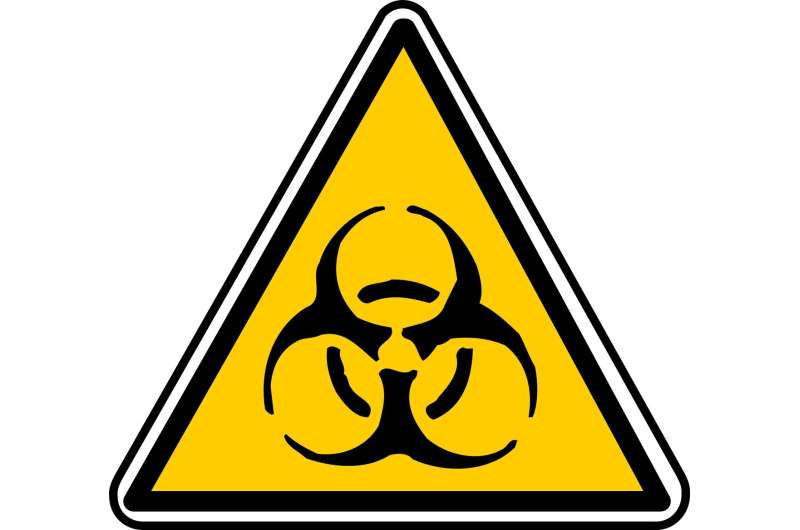Exposure to Agent Orange damages brain tissue in ways similar to Alzheimer's disease, study reveals

Agent Orange, an herbicide used during the Vietnam War, is a known toxin with wide-ranging health effects. Even though Agent Orange has not been used for decades, there is increasing interest in its effects on the brain health of aging veterans. A new study by scientists at Brown University reveals the mechanisms by which Agent Orange affects the brain and how those processes can lead to neurodegenerative diseases.
The research shows that exposures to Agent Orange herbicidal chemicals damage frontal lobe brain tissue of laboratory rats with molecular and biochemical abnormalities that are similar to those found in early-stage Alzheimer's disease. An early online version of this paper detailing the findings was published on Feb. 13 and is scheduled for publication in the Journal of Alzheimer's Disease.
The findings could have important implications for military veterans who were exposed to Agent Orange during the Vietnam War, said study author Dr. Suzanne M. De La Monte, a Brown University physician-scientist.
"If we can show that prior exposure to Agent Orange leads to subsequent neurodegenerative disease, then that gives veterans a chance to get help," De La Monte said.
But the study's findings have much broader significance, she added, because the toxins in Agent Orange are also present in lawn fertilizers.
"These chemicals don't just affect veterans; they affect our entire population," said De La Monte, who is a professor of pathology and laboratory medicine and neurosurgery at Brown's Warren Alpert Medical School.
Agent Orange is a synthetic defoliating herbicide that was widely used between 1965 and 1970 during the Vietnam War. Members of the U.S. military were exposed to the chemical when stationed close to enemy territory that had been sprayed by aircraft.
Government reports show that exposure to Agent Orange also caused birth defects and developmental disabilities in babies born to Vietnamese women residing in the affected areas. Over time, studies showed that exposure to Agent Orange was associated with an increased risk of some cancers as well as cardiovascular disease and diabetes.
Research also revealed associations between Agent Orange exposures and later development of nervous system degenerative diseases, and significantly higher rates and earlier onsets of dementia. However, in the absence of a proven causal link between Agent Orange and aging-associated diseases, there has been a need for studies that improve understanding of the process by which the herbicide affects the brain.
"Scientists realized that Agent Orange was a neurotoxin with potential long-term effects, but those weren't shown in a clear way," De La Monte said. "That's what we were able to show with this study."
The analysis was conducted by De La Monte and Dr. Ming Tong, a research associate in medicine at Brown; both are also associated with Rhode Island Hospital, an affiliate of the Warren Alpert Medical School. Their research builds upon their recent studies of exposure to Agent Orange chemicals on immature human cells from the central nervous system showing that short-term exposure to Agent Orange has neurotoxic and early degenerative effects related to Alzheimer's.
The researchers investigated the effects of the two main constituents of Agent Orange (2,4-dichlorophenoxyacetic acid and 2,4,5-trichlorophenoxyacetic acid) on markers of Alzheimer's neurodegeneration using the samples from the frontal lobes of laboratory rats. The mature, intact brain tissue samples included a full complex array of cell types and tissue structures.
The scientists treated the samples to cumulative exposure to Agent Orange, as well as to its separate chemical constituents, and observed the underlying mechanisms and molecular changes.
They found that treatment with Agent Orange and its constituents caused changes in the brain tissue corresponding to brain cell degeneration, and molecular and biochemical abnormalities indicative of cytotoxic injury, DNA damage and other issues.
The approach used by the researchers helped them better characterize the neuropathological, neurotoxic and neurodegenerative consequences of Agent Orange toxin exposures in young, otherwise healthy brains, as would have been the case for Vietnam War-era military personnel and many local residents in Vietnam.
"Looking for the early effects tells us that there is a problem that is going to cause trouble later on and also gives us a grip on the mechanism by which the agent is causing trouble," De La Monte said. "So if you were going to intervene, you would know to focus on that early effect, monitor it and try to reverse it."
Del La Monte hopes to be involved in additional research on human brain tissue to evaluate the long-term effects of Agent Orange exposures in relation to aging and progressive neurodegeneration in Vietnam War veterans.
The use of Agent Orange was prohibited by the U.S. government in 1971. However, the chemicals remain in the environment for decades, De La Monte said. According to the study authors, the widespread, uncontrolled use of Agent Orange in herbicide and pesticide products is such that one in three Americans has biomarker evidence of prior exposure.
Despite growing recognition of the broad toxic and carcinogenic effects of 2,4-dichlorophenoxyacetic acid, the researchers noted that concern has not achieved a level sufficient for federal agencies to ban its use. The researchers conclude that the results of this study and another recent publication support the notion that Agent Orange as well as its independent constituents (2,4-dichlorophenoxyacetic acid and 2,4,5-trichlorophenoxyacetic acid) exert alarming adverse effects on the mature brain and central nervous system.
"That's why it's so important to look into the effects of these chemicals," De La Monte said. "They are in the water; they are everywhere. We've all been exposed."
More information: Suzanne M. de la Monte et al, Agent Orange Herbicidal Toxin-Initiation of Alzheimer-Type Neurodegeneration, Journal of Alzheimer's Disease (2024). DOI: 10.3233/JAD-230881
Provided by Brown University
No comments:
Post a Comment